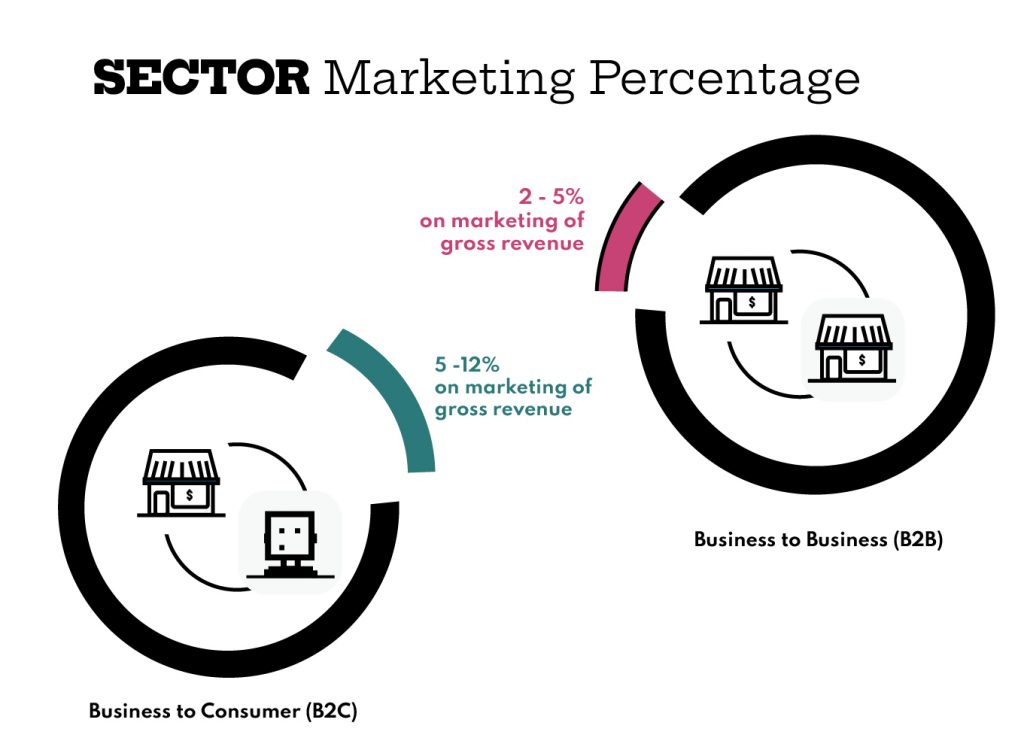10th March, 2021 by William Aldred
Introduction
A survey done by Business Development of Canada has stated on average small Canadians spend 30,000 a year on online marketing efforts and web development alone(Jessica Horvath, /). You’re probably asking, okay but how much should my business spend? and that is a good question as every business is unique and so should your budget, so our answer is simple, it depends.
We know, not helpful at first don’t worry within this blog we’ll simplify the “it depends” into a simple formula within this blog you can use, however before you do there are some factors to consider.
If you're after the formula for calculating your marketing budget then head down the page to "Calculating your Marketing Percentage Allocation"
What is a Marketing Budget?
Before we can show you the formula we first need to define a few things and we should start with the word ‘Marketing Budget’.
In simple terms, the marketing budget is a percentage of your gross revenue that is invested back into your marketing department.
Your marketing budget refers to all costs that are allocated to marketing, advertising, public relations, promotions, and anything else you might blanket under that very wide-cast net called ‘marketing’.
Marketing Budget, defined by Cordeeple
To work out what the percentage should be, we should address the two contributing factors that make up the allocated percentage amount of our marketing budget. We consider these factors to be what Sector your business operates in and whether you’re new to the Industry or well established. We’ve noticed that most businesses only use one or the other of these two factors, however, we believe both of these variables play an essential part in your budget creation, and below we’ll show you why these should be considered together.
The two defining factors that contribute to your marketing budget

Sector
Is whether your is business is tailored to the Business 2 Business(B2B) or Business to Consumer(B2C ) sector.

Industry
Are you established or new within the industry.
See, it’s simple.
These two factors will determine the percentage needed to calculate against your business gross revenue, but before we start let us define what these two factors mean to your business.
The Sector Definition
Here we will define the two sectors, Business to Business (B2B ) & Business to Consumer (B2C).
The Business to Consumer(B2C) industry is tailored for the consumers and when marketing to this industry, we’re appealing to the consumer’s emotions that focus on benefit and problem-solving. Consumers are known to change their minds more often than businesses so the budget tends to be higher to meet the ever-changing public and to compete against competitors. There tends to be an abundance of competitors in the Business to Consumer(B2C) marketplace.
Whereas the Business to Business(B2B) industry is aimed at industry professionals, and when marketing it’s ideal to focus on logic and illustrate the benefits on time, money, as well as resources saved through their product/services. Normally the competition is lower compared to the B2C marketplace
The Industry Definition
This question refers to the infancy of the business, whether the company is new (0-5 years) or established (5+ years). New companies’ first hurdle is surviving the first few years, as only 51% of new businesses survive their fifth year(Business Development of Canada, /). That’s why we believe that companies within the first 5 years require more support from their marketing department.

New Business
Little to no trust from the target audience at first and they have to convert the doubtful into loyal consumers which requires time, energy and I’m afraid money.

Established Business
Existing loyal customer database which contributes to a steady stream of revenue (Through social proof or repeat custom).
Now we’ve covered the definition of the two defining factors and why they should contribute to your budget plan. We’ll proceed to the next step, and that’s ensuring your business is categorized into the correct places.
Defining your sector B2B, or B2C?
Before you can use the formulas below, it’s time for you to determine what industry your business operates in. Check out the options and see which ones relate to you.
Business-to-Consumer (B2C) refers to selling products directly to customers, bypassing any third-party retailers, wholesalers, or any other middlemen. DTC brands are usually sold online only and specialize in a specific product category: Casper, Warby Parker, Everlane, Harry’s, Outdoor Voices, AWAY, and Dollar Shave Club
Wikipedia

You own a Salon which provides a service to the public.
B2C example, defined by Cordeeple
Business-to-Business (B2B) is a situation where one business makes a commercial transaction with another commercial institute. This typically occurs when: A business is sourcing materials for their production process for output. Example: Providing raw material to the other company that will produce output
Wikipedia

You are a wholesale distributor of Tea Bags that sells to retailers(Shops).
B2B example, defined by Cordeeple
We strongly recommend that a business should only target one of these two sectors as it helps with the tone of voice and marketing efforts. Getting this right first is the first crucial hurdle which will lie the foundations of your budgeting and marketing efforts.
Defining your industry, new or established?
Once you’ve determined whether you’re business operates in the B2B or B2C sector, then it’s time to determine the other factor that will contribute to the marketing funds and that is whether your business is new or established.
New: 0 – 5 years of business. You’re a start-up business of between 1 -50 employees looking to make an impact in the industry.
Chad Otar, 2018

A recently launched Hyrdopnic store with 3 members of staff. (14 months old)
New Business example, defined by Cordeeple
Established: 5+ years of business. You’ve made it past the crucial business years and now seeing enough healthy profits to expand.
Chad Otar, 2018

You own a Plant Nutrient company with over 30 employees that is established within your industry. (20 years old)
Established Company example, defined by Cordeeple
The percentage allocations to the two contributing factors.
We’ve outlined what the two contributing factors are and what they mean, so now it’s time for you to work out your marketing budget.
- Sector: Business Target Audience
- Industry: Age of business

In general 2-5% for the B2B marketing place & 5- 12% for the B2C industry.

In general 12 – 20 % for the New Companies and & 6 – 12% for Established business.
As we’ve mentioned before, these are the two essential factors to consider in your budget calculation as they are based on your business infancy and what sector your business operates in. Combined these will give you a reasonable and fair budget estimation.
Time to calculate your budget! Whoop whoop
Calculating your Marketing Percentage Allocation
It’s simple, add the Sector with the Industry divided by two will give you a marketing budget percentage to times against your gross revenue which will give you your Marketing Budget for the year.
(Sector + Industry) / 2 = Your Marketing Percentage Allocation
SECTOR
- Business to Business (B2B) = 2-5%
- Business to Consumer (B2C) = 5- 12%
INDUSTRY
- New Business = 12 – 20 %
- Estabished Company = 6 – 12%
We’ve given a range for all 4 possible outcomes, as this will also allow you to use your best judgment as to whether to use the full potential amount or the bare minimum. Then you times that by your gross revenue and there you have it, your Marketing Percentage Allocation. Don’t worry we give examples below of how to calculate your marketing budget.
Gross revenue is the total amount of sales recognized for a reporting period, prior to any deductions.
Gross revenue definition, defined by Accounting Tools, 2020.
Budget Examples
Take a look at the examples provided below to see how we calculate the marketing budgets based on the 4 possibilities.
New Business within the B2B Sector Budget Example
(New Business + B2B) /2 = Marketing Percentage Allocation x your Gross Revenue = Marketing Budget
(20 + 5) / 2 = 12.5% x 550,000 = $69,375
For our example, our small company has been in operation for 1 year and operates within the B2B sector. They have a gross revenue of $550,000. They’ve gone through the above and see that their marketing percentage is 12.5%. By taking our revenue (550,000) and multiplying it by our marketing percentage (.125), we have come to a marketing budget of $69,375 for our accounting period.
New Business within the B2C Sector Budget Example
(New Business + B2C) /2 ) = Marketing Percentage Allocation x your Gross revenue = Marketing Budget
(20 + 12) / 2 = 16% x 150,000 = $24,000
For our example, our small company has been in operation for 3 years and operates within the B2C sector. They have a gross revenue of $150,000. They’ve gone through the above and see that their marketing percentage is 16%. By taking our revenue (150,000) and multiplying it by our marketing percentage (.16), we have come to a marketing budget of $24,000 for our accounting period.
Established Business within the B2B Sector Budget Example
(Established Business + B2B) /2 = Marketing Percentage Allocation x your Gross revenue = Marketing Budget
(12 + 5) / 2 = 8.5% x 550,000 = $46,750
For our example, our established company of 8 years and operates within the B2B sector. They have a gross revenue of $550,000. They’ve gone through the above and see that their marketing percentage is 8.5%. By taking our revenue (550,000) and multiplying it by our marketing percentage (.085), we have come to a marketing budget of $46,750 for our accounting period.
Established Business within the B2C Sector
(Established Business + B2C) /2 = Marketing Percentage Allocation x your Gross revenue = Marketing Budget
(12 + 12) / 2 = 12% x 150,000 = $18,000
For example, an established company of 15 years that operates within the B2C sector. They have a gross revenue of $150,000. They’ve gone through the above and see that their marketing percentage is 12%. By taking our revenue (150,000) and multiplying it by our marketing percentage (.12), we have come to a marketing budget of $18,000 for our accounting period.

Yes, it sounds expensive however 33% of small business owners’ greatest challenge is a lack of funds (I.Mitic, 2021) and if you want your business to flourish then you need to reinvest back into your marketing department to ensure your business continues to exist in the coming years.
Summary
It depends, eh!
I know that wasn’t what you wanted to read in the first section of this blog. However, as we’ve explained, it’s not a simple question to answer as you first need to understand the two contributing factors to your budget Caluclations.
Sector and Industry will give you a good understanding of where you should fall in generating marketing budgets and it’s these two questions we ask before we give an answer to our clients. We do recommend that you do your own research and see what other businesses do.
According to Innovation, Science & Economic Development Canada statistics, thousands of businesses exit the marketplace every year in Canada. Business failure statistics show that about 96 percent of small businesses (1–99 employees) that enter the marketplace survive for one full year, 85 percent survive for three years and 70 percent survive for five years (Key Small Business Statistics). Approximately 7,000 businesses go bankrupt every year in Canada.
Susan Ward, 2019.
Don’t let your company become another failure statistic and align yourself with an agency that can help you make it within your industry as your success becomes our success.
Work Cited/ Resources
- Alex Kepka. (2020). Business Startup Statistics Canada (2021 Update). fundsquire.ca
- Accounting Tools. (2020). Gross revenue definition. accountingtools.com
- Business Development of Canada. (/). 10 things you (probably) didn’t know about Canadian SMEs. Bdc.ca
- Chad Otar. (2018). What Percentage Of Small Businesses Fail — And How Can You Avoid Being One Of Them?. forbes.com
- Cfhuron. (/). Canadian small business by the numbers. cfhuron.ca
- Jessica Horvath.(/). What is the average marketing budget for a small business? BDC.ca
- Guest Author. (2018). How to Calculate Your Marketing Budget [Infographic]. WordStream.com
- Guidant Financial. (2021). Small Business Trends: 2021. guidantfinancial.com
- I.Mitic (2021). Small Business Failure Statistics to Know in 2021 – A Realistic Picture. Fortunly.com
- Lendified. (/). 16 Facts About Small Businesses in Canada. lendified.com
- Patrick Whatman. (2020). Startup marketing budget: How to allocate and manage your expenses. spendesk.com
- Neil C. Churchill & Virginia L. Lewis. (1983). The Five Stages of Small Business Growth. hbr.org
- FreshBooks. (2020). 6 Business Milestones to Hit in Your First 5 Years. Freshbooks.com
- Government of Canada (2018). Canadian New Firms: Birth and Survival Rates over the Period 2002–2014, May 2018. ic.gc.ca
- Government of Canada (2019). Archived — Key Small Business Statistics – January 2019. ic.gc.ca
- Susan Ward. (2019). Why Small Businesses Fail and How to Avoid Failure. thebalancesmb.com






